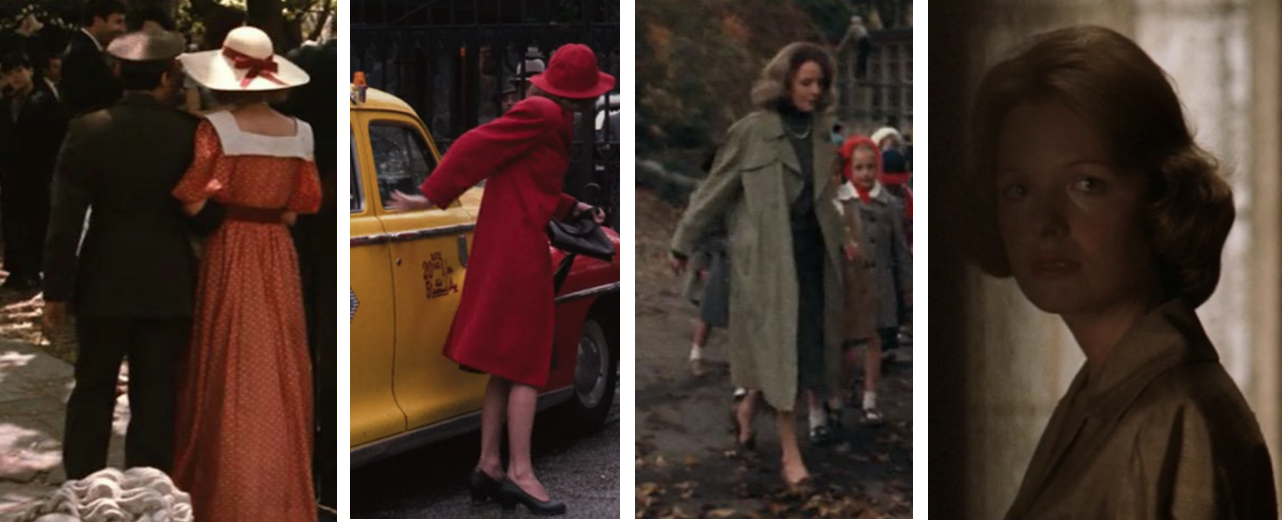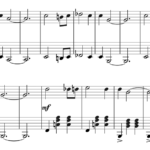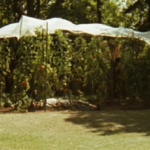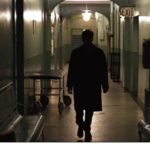Hemmed In: Kay Adams and Her Changing Fashions
By Emma Hager
Anna Hill Johnstone, the costume designer for The Godfather, knew how to make male antiheroes into fashion icons. In the mid-’50s, she outfitted the cool of Marlon Brando in On the Waterfront and of James Dean in East of Eden. On The Godfather—for which she received an Oscar nomination—she turned Al Pacino (dubbed “the midget” by producer Robert Evans) into an icon of slow-burning glamour with his dark three-piece suits and his tilted homburg hat.
Given that women speak all too rarely in the film, it’s especially important that we dwell on how their clothes speak for them.
What is often gravely overlooked is how much Johnstone’s genius—meticulous, deliberate, pointed—shaped the women’s fashions in the film. This is not surprising given how much the film trades in the currency of masculinity. Women in the film—or at least the idea of them—act as magnets of male ambition, motive, and desire. From a symbolic standpoint, that’s a powerful position to be in, but it’s also a problem that The Godfather’s women serve mostly as conduits for a story about men’s feuds and men’s business.
Given that women speak all too rarely in the film, it’s especially important that we dwell on how their clothes speak for them. We need to pay attention, when we can, to the pouf of a sleeve or the hem of a dress; they offer a lexicon cut from different cloth, whose words are quite revealing.
Corleones, meet Kay
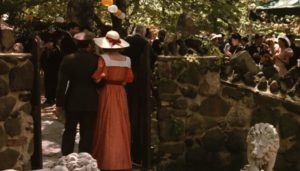 Our first glimpse of Kay Adams (Diane Keaton) is from behind. She’s just arrived at Connie and Carlo’s wedding with her beau, Michael Corleone, a Marine back from the War. Michael, in a display of patriotism or of rote performance, wears his brown and boxy uniform. It’s well-tailored and simple—stoic, even, what with its precise hems.
Our first glimpse of Kay Adams (Diane Keaton) is from behind. She’s just arrived at Connie and Carlo’s wedding with her beau, Michael Corleone, a Marine back from the War. Michael, in a display of patriotism or of rote performance, wears his brown and boxy uniform. It’s well-tailored and simple—stoic, even, what with its precise hems.
Next to Kay, Michael and his uniform nearly disappear, swallowed by the aimless enormity of her gown. Because it’s orange-y-red with polka dots, parachuted at the sleeves, and generously petticoated, the gown would swallow Kay entirely, too, if it weren’t for its fitted waist. The burgundy belt is there as if to say there’s a person, here, underneath it all.
Kay has not dressed inappropriately for the wedding; there’s plenty of lace and tulle and crinoline to go around. Corleone women and guests jaunt about the scene, too, in garments of similar volume, yet the mostly pinks and otherwise pastels of their dresses offset Kay’s red look entirely. If all the other women look similarly elaborate and cartoonish, it’s in a different way. They’re like cakes, tiered and frothy, and Kay the sole tablecloth upon which to place them. This is an outdoor ceremony, after all, and her large look enough to be a picnicking surface.
It would be easy to dismiss this sartorial difference as one of mere taste; one might conjecture that Kay has chosen her dress from a different page of the Saks catalog. But this is a film whose aesthetic choices are excruciatingly deliberate, reflecting its grave polarities (good vs. bad) and ultimatums (life vs. death). Matters of taste are also ones of allegiance. And so it is through Kay’s laughably floppy gown, what with all its unwitting kitsch, that we’re first encouraged to be skeptical of the viability of Kay’s position in the family. Sure, the dress has an Americana charm, recalling Sunday drives and Wonder Bread, and may suggest an aspirational innocence, or a WASP-y posture, but already the contrasts are too stark to be easily resolved.
There will be no seamless synthesis into the family, nor will Kay ever be a raw and ready object of desire. Her beauty is sensible, lucrative; it frames her New Hampshire, Baptist upbringing, to which Michael turns, initially, as a means of Americanizing his life.
The Apollonia Distraction
To be naturalized, in some ways, through Kay, is a decent goal. But there’s still the immediate and irresistible allure of Apollonia Vitelli (Simonetta Stefanelli), Michael’s young and virginal bride whom he meets while hiding in Sicily. Her beauty is bewitching, her eyes rich and mysterious, her lips plush and pink. And Michael, upon seeing Apollonia for the first time as she comes traipsing up a dusty trail, goes still; he has been, in the words of his bodyguard, “struck by a thunderbolt.”
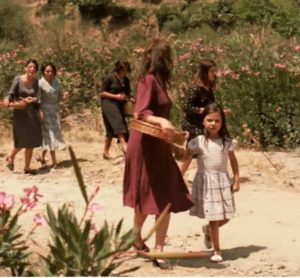 Indeed, our first glimpse of Apollonia — perhaps because it is also Michael’s — is a carnal yet unfussy one. Her burgundy dress, knee-length and loose but still generous to her feminine contours, takes up the movement of the wind. Its lightness means it could blow up, or off, at any moment, like she’s something to be undone. Unlike Kay’s saccharine and synthetic wedding ensemble, Apollonia’s dress, with its airiness and earthen tone, complement the browns and reds of the scorched Sicilian landscape. She’s of the earth, pure, and a desire for her is only natural. Michael has returned to his family’s point of origin, and the relative ease with which he dons the ubiquitous newsboy hat and flowy, peasant blouse — as opposed to his stiffness in the stiff Marines suit — finds its assuring companion in the nonchalance of Apollonia’s garment.
Indeed, our first glimpse of Apollonia — perhaps because it is also Michael’s — is a carnal yet unfussy one. Her burgundy dress, knee-length and loose but still generous to her feminine contours, takes up the movement of the wind. Its lightness means it could blow up, or off, at any moment, like she’s something to be undone. Unlike Kay’s saccharine and synthetic wedding ensemble, Apollonia’s dress, with its airiness and earthen tone, complement the browns and reds of the scorched Sicilian landscape. She’s of the earth, pure, and a desire for her is only natural. Michael has returned to his family’s point of origin, and the relative ease with which he dons the ubiquitous newsboy hat and flowy, peasant blouse — as opposed to his stiffness in the stiff Marines suit — finds its assuring companion in the nonchalance of Apollonia’s garment.
To my mind, if Kay recalls the sort of competent women played by the actress Theresa Wright in the postwar period, then Apollonia is a sort of Lolita figure. She’s Michael’s own kind of Nabokovian nymphet.
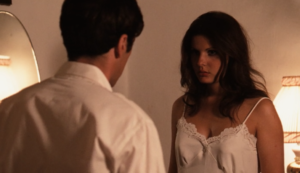 Nowhere in the film are we confronted with the archetypal contrasts of these women more than in an abrupt scene cut from one woman to the next, which cuts across geography and cloth. We start, in one moment, with an intimate scene between Michael and Apollonia. It’s the evening of their wedding, which occurred earlier in the day, and they appear now in white in their bedroom. Michael is in an unbuttoned dress shirt; Apollonia in an ivory negligee. He inches toward her. And while she’s initially hesitant with all the qualms of inexperience, the pencil-thin straps of her negligee fall away from her shoulders. They kiss.
Nowhere in the film are we confronted with the archetypal contrasts of these women more than in an abrupt scene cut from one woman to the next, which cuts across geography and cloth. We start, in one moment, with an intimate scene between Michael and Apollonia. It’s the evening of their wedding, which occurred earlier in the day, and they appear now in white in their bedroom. Michael is in an unbuttoned dress shirt; Apollonia in an ivory negligee. He inches toward her. And while she’s initially hesitant with all the qualms of inexperience, the pencil-thin straps of her negligee fall away from her shoulders. They kiss.
Back in America, Kay Can’t Get Through
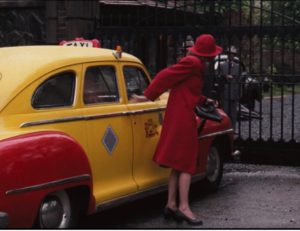 The camera cuts abruptly, back to America, where Kay exits a red and yellow taxi outside the Corleone compound. She’s on a mission. She wants to get in touch with Michael, though Tom Hagen (Robert Duvall), who meets her at the compound gates, refuses to pass on her letter to for fear of being further implicated in Michael’s hiding.
The camera cuts abruptly, back to America, where Kay exits a red and yellow taxi outside the Corleone compound. She’s on a mission. She wants to get in touch with Michael, though Tom Hagen (Robert Duvall), who meets her at the compound gates, refuses to pass on her letter to for fear of being further implicated in Michael’s hiding.
Kay’s ensemble here is signature to her. It sticks to the register of her previous looks: she wears a rounded, red coat and a matching hat. The tablecloth-like quality of her first look is preserved through the polka-dotted blouse. But when it’s set against the backdrop of the preceding scene, which is doused in Apollonia’s wanton energy, the outfit choice is made jarring. The tailoring is sure and strong, but the coat’s ketchup-like color is almost droll. This is not the crimson of desire; she must pursue Michael, find him out, though he retreats to the bosom of Apollonia.
Assuming, Subsuming
Eventually, Michael returns to the United States; Apollonia dies in an accident. Lust, like happiness, is mostly fleeting. There’s business to do and an American posture to assume again. Kay is, as mentioned, integral to this Americanization. It’s fitting that their first reunion, since Michael’s Sicily tenure, occurs outside the school where Kay is employed.
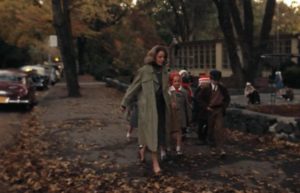 Michael emerges from a smooth, black car in a smooth, black overcoat; Kay struggles to keep the schoolchildren in line. She’s got on a trench coat — just more beige than a sea-foam green — a knitted skirt set, brown loafers and a string of pearls. She’s styled her hair into a bouffant, and it’s the most pronounced and animated aspect of her new, otherwise demure look. Gone are the tomato reds and roadside dining patterns.
Michael emerges from a smooth, black car in a smooth, black overcoat; Kay struggles to keep the schoolchildren in line. She’s got on a trench coat — just more beige than a sea-foam green — a knitted skirt set, brown loafers and a string of pearls. She’s styled her hair into a bouffant, and it’s the most pronounced and animated aspect of her new, otherwise demure look. Gone are the tomato reds and roadside dining patterns.
While Kay’s power, to the extent we can conceive it as such, has never been a sexual one, this outfit helps to eradicate all previous hints of vibrance. Kay’s function is more pragmatically strict than ever, and Michael’s marriage proposal to her is more an admission of defeat—of how he’s working in a mode of ‘damage control’—than it is a demonstrated commitment to some ineffable bond. Kay professes it’s “too late” when Michael expresses his tenderness in the form of an addendum: “and I love you.” Only it’s not about that, of course, and anything beyond the transactional is muted — just like the green of Kay’s coat.
The Shadow of Doubt
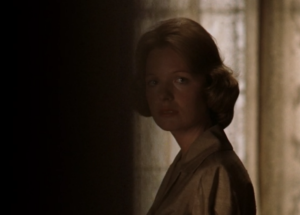 The film closes with a closed door. The last shot is of a defeated-looking Kay, who stands in the frame of Michael’s office, looking longingly into its interior. Inside, there’s a world to which she’s not welcome. Kay cannot stay, and eventually one mafioso shuts the door on her; the shadow is increasingly cast upon her face until we get only her vague outline.
The film closes with a closed door. The last shot is of a defeated-looking Kay, who stands in the frame of Michael’s office, looking longingly into its interior. Inside, there’s a world to which she’s not welcome. Kay cannot stay, and eventually one mafioso shuts the door on her; the shadow is increasingly cast upon her face until we get only her vague outline.
It’s a peculiar and compelling choice for an ending since it privileges the female as its object, but is explicitly exclusionary in its shutting the door on her. But perhaps this makes perfect sense for Kay, and more so when we consider her “purpose.” Michael has fully assumed his role; Kay has given him children. A transaction complete. A door closed.
In her final outfit, Kay’s features do not stand out, and it’s as if she has faded into the role of herself.
As the men buckle down for business , we see Kay buttoned up in a golden-beige shirtdress. It’s a fitted garment, for the most part, with only a slight flare of the skirt rendering any semblance to the comic largeness of her first look. Her hair has the same champagne glow as the fabric. Kay’s features do not stand out, then, and it’s as if she has faded into the role of herself.
Uncertainty and doubt invade the last shot, take over Kay’s face, but at least the lines of her dress are stiff and sure. A domestic armor.
Emma Hager (‘18) is a senior at the University of California, Berkeley, where she studies English literature. Regrettably, she still has yet to read Middlemarch.

